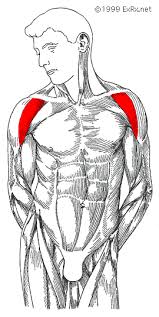Your shoulders do a lot of work throughout the day. You need them to lift, pull, push, and reach, and even to walk and sit up straight.
It’s no wonder they sometimes feel tired or tight, and may feel achy or stiff after a workout. One effective way to keep your shoulders flexible is by doing deltoid stretches.
The deltoid muscle is situated around the top of your upper arm and shoulder. Its main purpose is to help you lift and rotate your arm.
The deltoid muscle has three parts: anterior, lateral, and posterior. These muscles all work together to keep your shoulders stable.
In this article, we’ll look at specific deltoid stretches that may help keep your shoulders flexible and less prone to aches and pain.
Stretching is really good for you and deltoid stretches are no different. As the name implies, these stretches primarily target your deltoid, and can provide a variety of benefits.
Deltoid stretches may help:
- increase the flexibility and range of motion of your deltoid muscle
- reduce tightness and tension in your shoulders
- improve your posture
- reduce your chance of shoulder injury and pain
- boost your athletic performance
Many chest-related movements involve your anterior deltoid. If this muscle gets tense or tired, it can affect your posture and increase your risk of injury, especially when working out.
Stretching your anterior deltoid can help open up the front of your body, which can help counteract tightness or stiffness. This exercise can also help increase the flexibility and range of motion of your anterior deltoid.
The anterior deltoid stretch is a simple movement that stretches the front of your shoulder, as well as your pectorals. You can do this exercise without any equipment.
How to do an anterior deltoid stretch
You can perform the anterior deltoid stretch standing or seated — just keep your feet firmly planted and your back straight.
- With your spine straight, reach your arms behind you and interlace your fingers. If you can’t interlace your fingers, grab opposite wrists or elbows or try grasping a small towel with each hand.
- Roll your shoulders back to sit up tall, allowing your chest to open up, and gently squeeze your shoulder blades together.
- Moving slowly, carefully straighten your arms.
- Next, gradually begin to raise your arms behind you, moving only as far as you can maintain an upright posture. Stop once you feel a stretch.
- Pause, breathing deeply into the stretch.
- Repeat 2 to 3 times, as needed.
Although your anterior deltoid tends to be fairly dominant in a lot of exercise movements, it’s equally important to stretch your posterior deltoid.
This stretch focuses on the back of your shoulder, but it’s normal to feel the stretch working in your triceps and shoulder blade too.
The American Academy of Orthopedic Surgeons (AAOS) recommends this stretch to prevent injury and improve range of motion.
How to do a posterior deltoid stretch
To perform the posterior deltoid stretch, start in a standing or seated position with your spine straight.
- Relax your shoulders.
- Reach one arm across your body, using your other arm or wrist to hold it gently by your upper arm.
- Slowly begin to pull your arm toward your chest, as far as possible, allowing the stretch to reach deep into the back of your shoulder.
- Pause, breathing deeply into the stretch. Hold for at least 30 seconds.
- Release and repeat with the other arm.
To stay safe during deltoid stretches, keep these safety precautions in mind.
- Don’t push too hard. While deltoid stretches might be uncomfortable, especially if you’re stiff, avoid stretching to the point of pain.
- Don’t bounce. Ballistic stretching can be dangerous, so avoid bouncing in your stretches unless directed by your doctor or physical therapist.
- Go slowly. Stretches are meant to be slow and gentle, so don’t rush to complete a stretch.
- If you have an acute or chronic injury, speak to your doctor or physical therapist before performing these stretches.
- If you aren’t able to perform the stretch properly, don’t force your body into it. Talk to a doctor or physical therapist about alternatives that can help you increase your flexibility.
If you’re looking to incorporate deltoid stretches into your workouts, make sure you warm up first.
The AAOS suggests adding a few minutes of stretches at the end of your warm up — to help get your deltoids ready for exercise — and also at the end as part of your cool-down.
Studies show that stretching after a workout may be beneficial in recovery and reducing muscle soreness.
Deltoid stretches can help improve the flexibility and range of motion in your shoulder muscles.
These stretches may also help ease stress and tension in your shoulders, and reduce the risk of injury when you’re working out or doing a lot of reaching or lifting.
Follow up with your doctor or physical therapist if you have shoulder pain or stiffness that doesn’t go away or gets worse over time. They can help you identify the cause of your pain, and can create a plan for safe and effective relief.
